In 2021 students and young researchers created research posters to present their innovative ideas and research in regards to the UN Sustainable Development Goal 10: Reduced Inequalities.
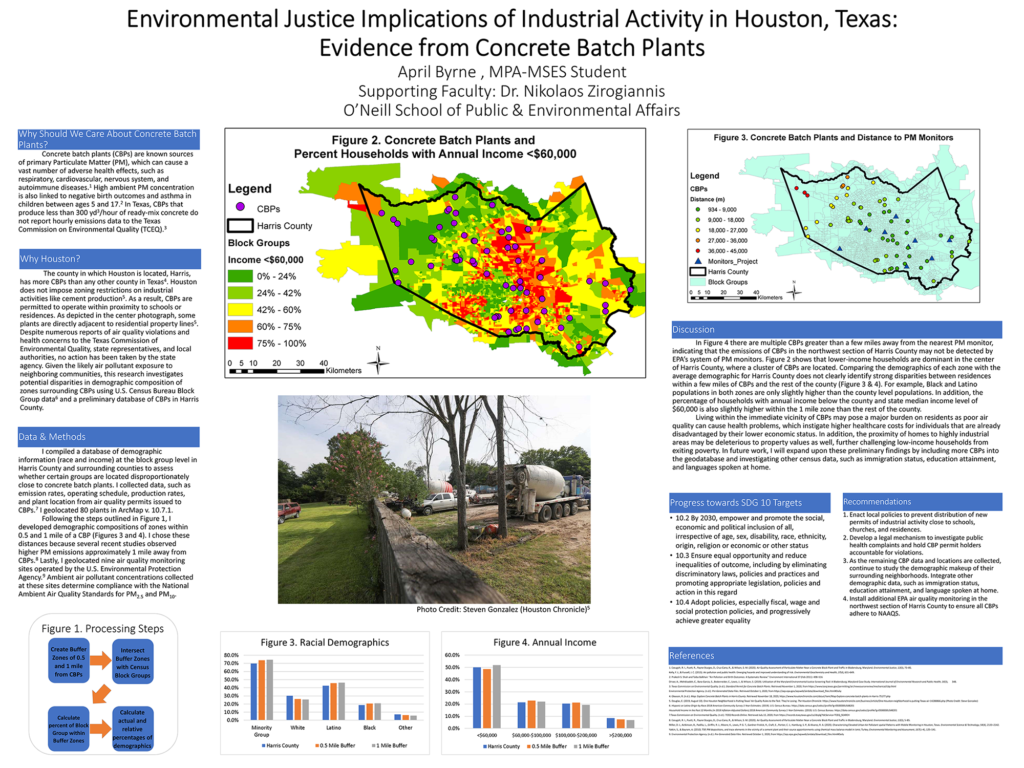
Indiana University
Graduate: April Byrne
Faculty mentor: Nikolaos Zirogiannis
Commission on Environmental Quality due to their lower production rates. Furthermore, because Houston, Texas does not have industrial zoning ordinances for concrete batch plants, plants may operate close to residences and schools, potentially exposing the local community to harmful air pollutants. Given Harris County’s predominantly large makeup of minority groups in comparison to the rest of Texas, there is cause for concern that the lack of industrial zoning ordinances may disproportionately harm people of color and/or vulnerable age groups. Furthermore, because TCEQ has not responded appropriately to citizen concerns and CBP violations, residents do not have the effective means to protect themselves from health hazards. I investigate any disparities in the economic and racial makeup of households within close proximity to batch plants using U.S. Census block group data.

Moi University
Undergraduate: Ashwinder Bhamra
Faculty mentor: Kirtika Patel
The Beyond Sciences Initiative (BSI) is a consortium of scholars and professionals in the health sciences with a common goal to advance global cooperation in the health sciences and beyond. The project described in this presentation defines the activities of the local chapter at the Moi University College of Health Sciences, Kenya, which centre around learning more about the social problems being faced by communities around them. This includes activities that involve working with marginalised communities such as street children and women, neglected children, and, refugees.
The Kakuma Refugee Camp was established in 1992 following political and social misfortunes in the horn of Africa region. Physically located in Northern Kenya, it remains independently set up by the UNHCR, but works in partnership with the Government of Kenya, and other agencies to provide security and other basic needs and services. Unfortunately, not all needs in areas such as education can be met fully given resource constraints.
The overall aim of the program was to connect with a population group within the camp who are at a point in their lives such that they can become instrumental drivers of change in the communities around them, and yet are able to connect with the young BSI team to allow them to be able to freely share their experiences and challenges. Education therefore became a central focus given its unmet need in among the youth in the camp, as well as its transformative impact that can be realized to life beyond the camp. The programme set up as a mentorship programme that helps connect members of the BSI with high school students at the Kakuma Refugee camp to foster sharing of ideas and experiences and working towards possible solutions with each subsequent visit, the findings of one of which have been presented here.
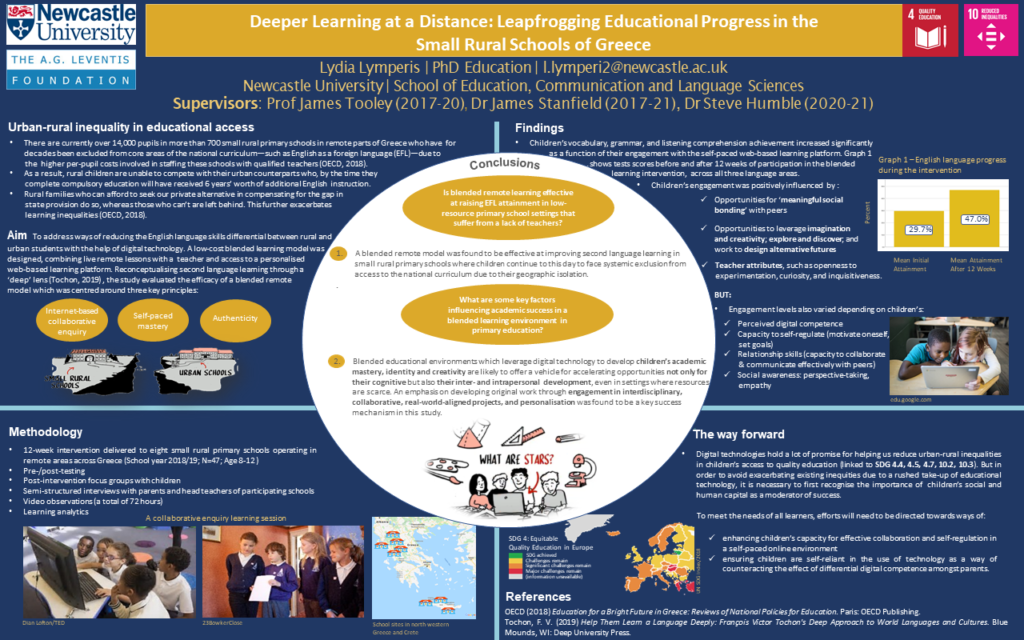
Newcastle University
Graduate: Lydia Lymperis
Faculty mentors: Prof James Tooley (2017-20), Dr James Stanfield (2017-21), Dr Steve Humble (2020-21)
The poster presents a PhD research project whose aim was to address ways of reducing the English language skills differential between rural and urban students in Greece with the help of digital technology. A low-cost blended learning model was designed, combining live remote lessons with a teacher and access to a personalised web-based learning platform and an intervention was delivered to 47 pupils aged 8-12 attending eight different small rural schools across the country. Reconceptualising second language learning through a ‘deep’ lens, the study evaluated the efficacy of a blended remote model which was centred around three key principles: collaborative enquiry, self-paced mastery and authenticity. Results are reported in terms of children’s learning outcomes, as well as elements of the intervention, child characteristics and environmental factors that were perceived to have mediated and/or inhibited children’s progress. Finally, policy implications regarding the design of low-cost remote learning systems for marginalised rural populations are discussed.
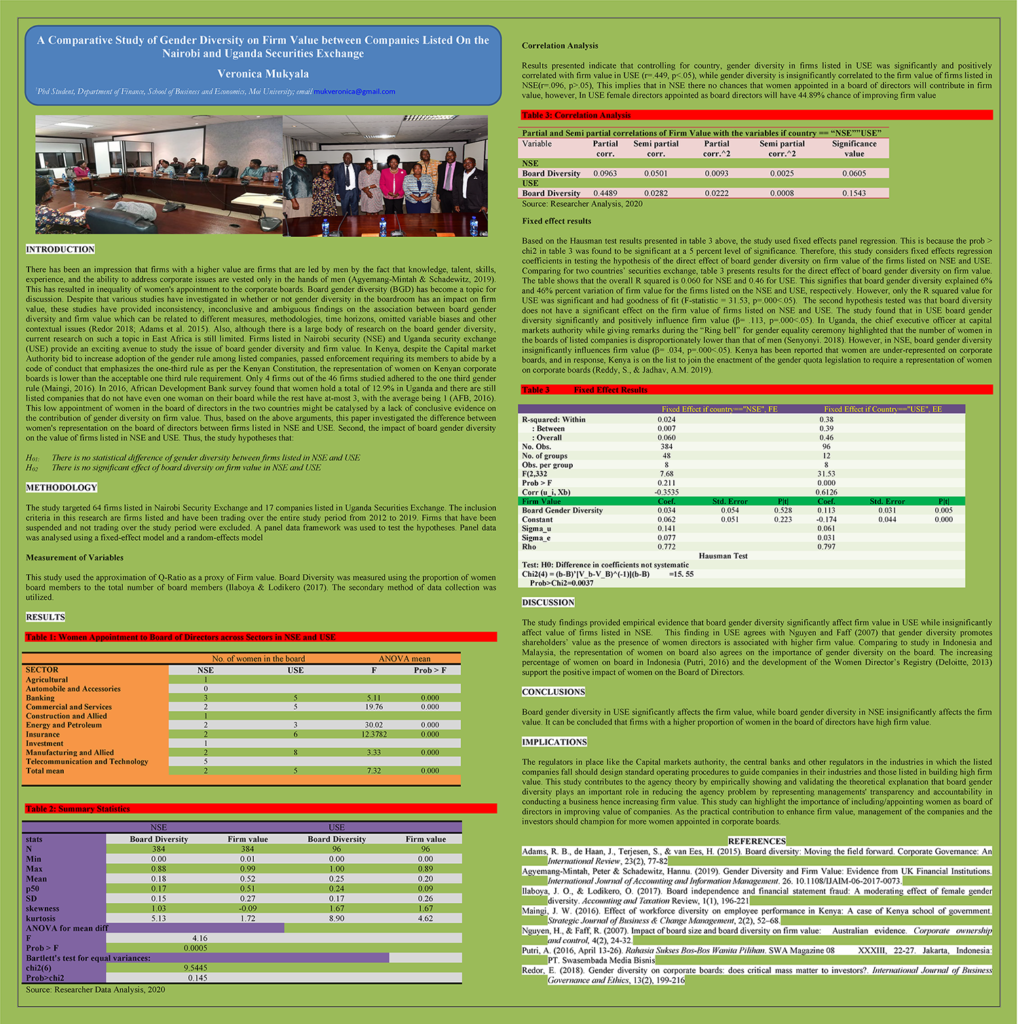
Moi University
Graduate: Veronica Mukyala
The study was conducted in Kenya and Uganda targeting 64 firms listed in Nairobi Securities Exchange (NSE) and 17 firms listed in Uganda Securities exchange (USE). Firms that had consistently traded from 2012 to 2019 were the ones considered and a panel data framework was used to test the hypotheses. The study investigated the difference between women’s representation in the board of directors between firms listed in Nairobi Security exchange and Uganda Security exchange, It also investigated the impact of board gender diversity on the value of firms listed in NSE and USE. The findings showed that board gender diversity in USE significantly affects firm value while board gender diversity in NSE insignificantly affects firm value.
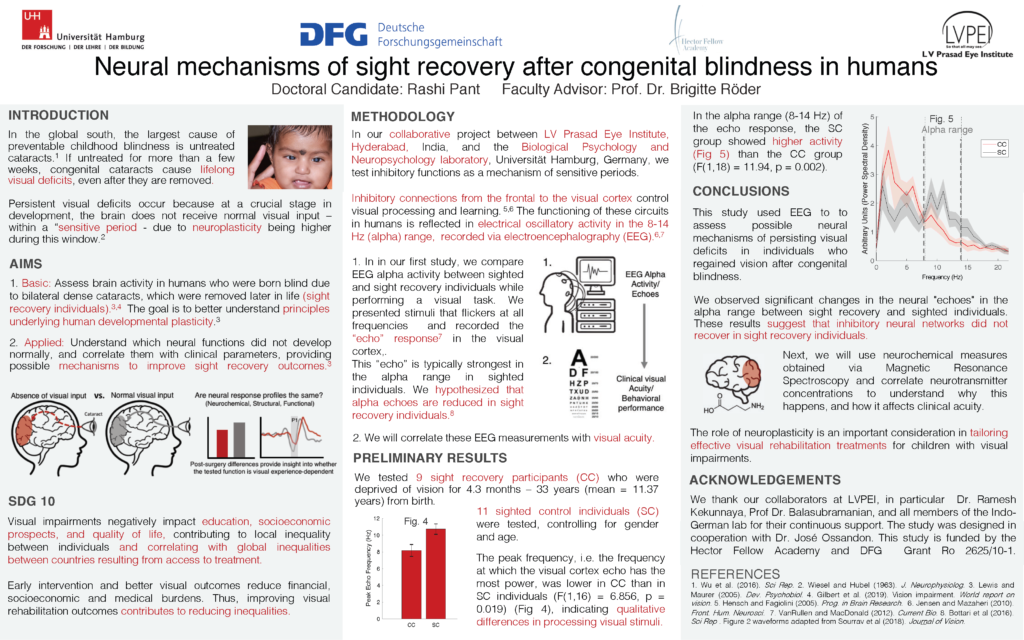
Universität Hamburg
Graduate: Rashi Pant
Faculty mentor: Brigitte Roeder
Globally, one of the primary causes of preventable blindness is congenital cataracts. Children who are born blind due to cataracts suffer from permanent, long term visual deficits if the cataracts are not removed within a few weeks from birth. This occurs due to time windows in development called sensitive periods, wherein if normal vision is not received within this window, neural development of the circuits that support vision is abnormal. Obtaining access to treatment is more difficult in developing and under-developed areas, and visual impairments can reduce educational and employment opportunities, perpetuating the existing social and economic inequalities.
This project aims to understand how neural plasticity affects vision after recovery from cataracts. We compare neural activity in individuals who received delayed treatment for congenital cataracts to that of normally sighted individuals, and we aim to correlate these neural measures with clinical visual acuity. Our poster highlights a study of this project wherein we find differences in inhibitory neural circuits between sight recovery individuals and normally sighted individuals, providing evidence that inhibitory activity might regulate sensitive period plasticity.
Understanding the neural mechanisms of sight recovery can help visual rehabilitation techniques. By improving visual outcomes after congenital cataract surgery, we hope to improve the quality of life and socioeconomic prospects of children that received delayed treatment, and as per SDG10, lessen existing inequalities.
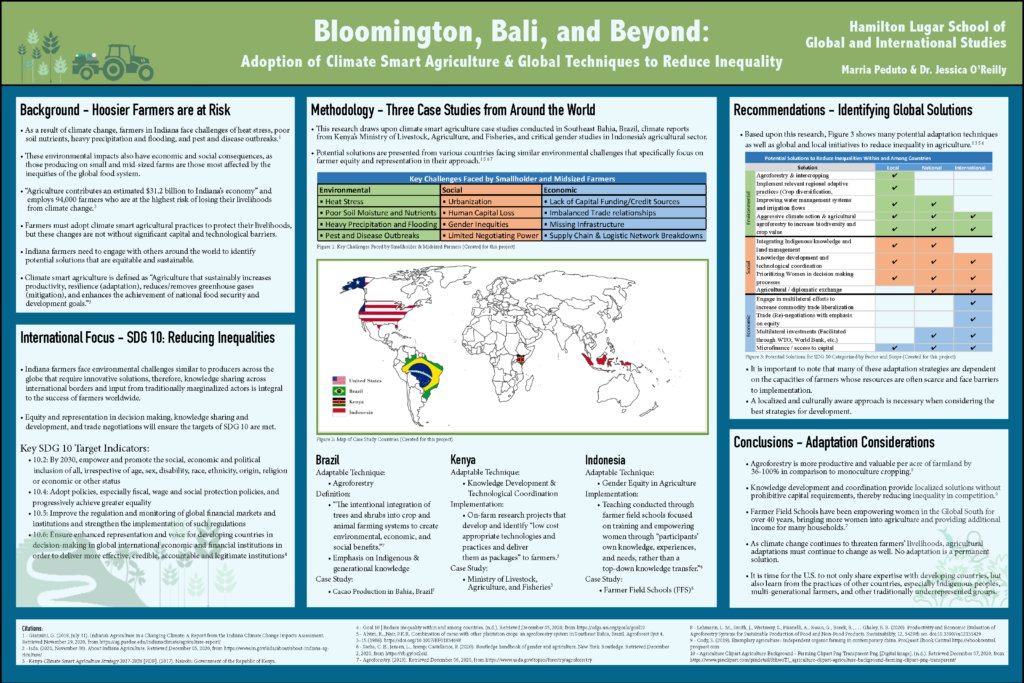
Indiana University
Undergraduate: Marria Pedutoe
Faculty mentor: Jessica O’Reilly
Worldwide agricultural production is expected to face increasing challenges in the next ten years as a result of climate change, which will leave an indelible impact on the incomes of American smallholder and mid-sized farmers and those in developing countries. Farmers in Indiana face challenges of heat stress, poor soil moisture and nutrients, heavy precipitation and flooding, and pest and disease outbreaks – similar challenges faced by farmers thousands of miles away in Brazil, Kenya, and Indonesia.
Farmers must adopt climate smart agricultural practices to protect their livelihoods, but these changes are not without significant capital and technological barriers. This project first introduces the key environmental, social, and economic challenges faced by smallholder and midsized farmers, then potential solutions are presented from government initiatives and organizations that emphasize farmer equity and representation in their approach. Examining three case studies from Brazil, Kenya, and Indonesia, this project introduces three potential solutions for farmers in Indiana and highlights the importance of mutual knowledge sharing and cross-border cooperation to reduce inequalities for farmers across the globe.
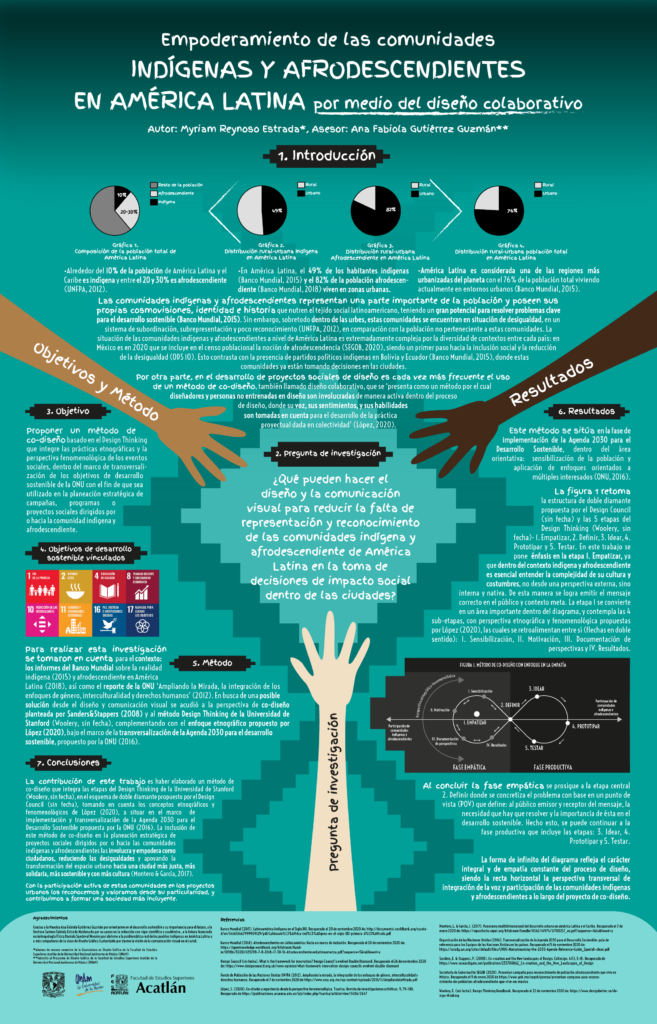
National Autonomous University of Mexico
Undergraduate: Myriam Reynoso-Estrada
Faculty mentor: Ana Fabiola Gutiérrez Guzmán
‘‘Empowerment of indigenous and afro-descendant communities through the use of collaborative design’’
Latin America is a region with great cultural diversity, where at least a quarter of the population belongs to indigenous and afro-descendant communities. Moreover, we find in urban areas a severe and multifactorial inequality situation affecting primarily these communities. It is worth noting that at least half of the total population of both indigenous and afro-descendant communities live inside cities. Dealing with this situation is directly related to the tenth sustainable goal: reduced inequalities. On the other hand, in the design field, the co-design or collaborative design method has been used in the development of social projects. Based on these facts, the following question arises: How can graphic design and visual communication contribute to the reduction of lack of recognition and representation of Latin American indigenous and afro-descendant communities in decision-making processes of social impact inside the cities? To answer this question, and thus following on the 2030 Agenda of the United Nations, a co-design method focused on empathy is proposed. In this work, the five steps of the “Design Thinking” method of the University of Stanford (Woolery, undated) were included in the “Double Diamond” scheme of the Design Council, taking into account the ethnographical and phenomenological concepts by Lopez (2020). This study is a theoretical one, and the proposed co-design method needs to be tested in a social project in order to assess its effectiveness.
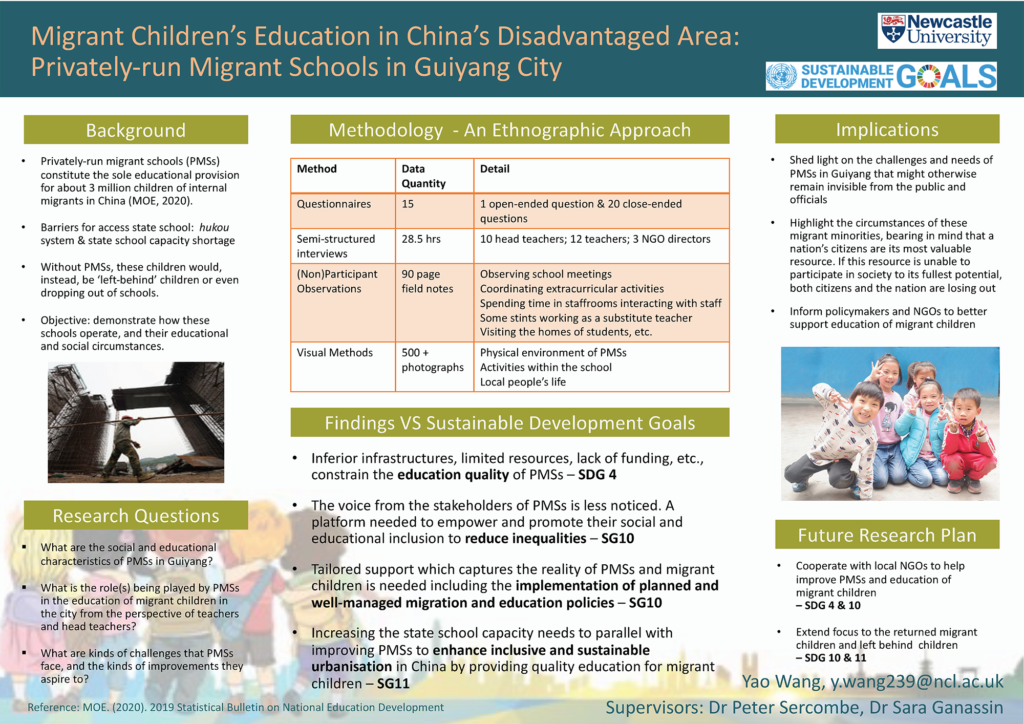
Newcastle University
Graduate: Yao Wang
Faculty mentor: Peter Sercombe
Privately-run migrant schools (PMSs) constitute the main educational provision for the children of internal migrants in China’s fast-developing cities. They provide an important educational opportunity for the children of migrant parents who would, instead, be ‘left-behind’ children or have no educational opportunities. The Chinese educational system devolves responsibility for compulsory education to local governments, at the county or district level. Funding for compulsory education is allocated by the number of children with a hukou, and does not transfer across administrative units. Although the central government urges local authorities to accommodate the educational needs of migrant children, they lack incentives and financial resources. As a result, PMSs spring up to cater for migrant children’ educational needs. This research will demonstrate how these schools operate and the improvements they aspire to. Different from previous studies, which tend to study PMSs in highly developed cities, such as Beijing and Shanghai, it focuses on schools in a relatively poor but burgeoning city, Guiyang, the capital city of one of China’s least developed provinces – Guizhou. There are insufficient studies on Guiyang in China or beyond. However, grassroots privately-run migrant schools are mushrooming in cities, such as this. This project adopts an ethnographic approach on the basis that this is the most productive way to address my research questions about the characteristics (demographic, financial & infrastructural) of PMSs in Guiyang, the role(s) being played by PMSs in the education of migrant children in the city, the kinds of challenges that PMSs face, and the kinds of improvements they aspire to, according to the main stakeholders. It adopted multiple methods including questionnaires, semi-structured interviews, visual methods, and observations. Overall, this research aims to shed light on the challenges and needs of PMSs that might otherwise remain invisible to the public and officials.